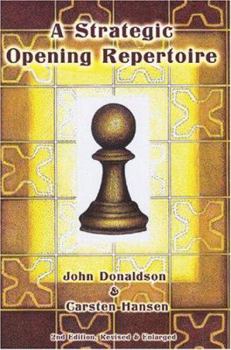A Strategic Opening Repertoire
This new edition of A Strategic Opening Repertoire is both revised and expanded. The lines presented here – based on 1. Nf3, 2.c4 and 3.g3 – will serve a player well throughout his career as they are... This description may be from another edition of this product.
Format:Paperback
Language:English
ISBN:1888690410
ISBN13:9781888690415
Release Date:February 2015
Publisher:Russell Enterprises
Length:272 Pages
Weight:0.90 lbs.
Dimensions:0.6" x 6.3" x 9.0"
Customer Reviews
3 ratings
Cohesive and durable
Published by Thriftbooks.com User , 16 years ago
This repertoire is very cohesive - it seeks positions which as much as possible are of a similar nature and so allows the player to build familiarity with them. It appears to be a repertoire that is durable and is not likely to be refuted. It is positionally focused and does not always take the most critical lines. It includes some very theoretical lines and also deliberately avoids others, so I would say the theme of the book is to offer a holistic, cohesive positional repertoire rather than to avoid theory. The upside is that it provides a very well thought out roadmap for the advanced player. You are paying for the experience the authors have in selecting lines and for their ability to explain the lines. The downside for me is that it's written for an advanced audience (2000-2400) so the explanations are not "entry level". But it's unfair to blame the book for that - it is very explicit about its intended audience. What you will discover inside its pages is classy positional chess. That's why I rate it so highly. There are hundreds of games, all in the scope of the repertoire, with very revealing annotations. What you will find if you persevere is that you start to build familiarity with the positions, bit by bit. Like every repertoire you are going to get varied responses and play lots of different positions, but you will get enough repetition to get some decent learning experiences. If you want a positional repertoire, you can be confident that you are not wasting your time, but expect hard work.
Yes! A Strategic Answer to the King's Indian Defense
Published by Thriftbooks.com User , 24 years ago
Donaldson's book centers around a system that uses the opening moves 1. Nf3, 2. c4, 3. g3. Donaldson writes that he is aiming the book at players at the Expert to Master level. Thus, the chapters contain game after game, with in-line variations and relatively terse but clear commentary. Despite being 200 USCF rating points below the stated audience (at the edge between B and A), I am finding the book exciting and helpful, because it does, more than any other opening repertoire book I've seen, fulfill its promise of providing a strategically based opening lines that work! The first five chapters deal with Black's attempt at a defense based on the King's Indian setup, which in effect turns into a Closed-Sicilian Reversed. As a player with a definite dislike for games that plunge into heavy tactics, these five chapters are an answer to a prayer. Since the center pawns don't get locked up as they do in the KID, Black rarely has the opportunity to launch the dangerous mating attacks so common in the classical KID, and White is safely able to bring play to the queenside where he retains an advantage. A nice plus is that the anti-KID system practically plays itself for the first 10 moves, and play continues in clear strategic directions thereafter. Dedicated KID players seem to be unfamiliar with this approach, thus I often find myself with big time advantages as well as a positional plus going into the middle-game. I don't know of any other work that deals with this opening line to this depth, and would give this book four stars for this section alone. Other chapters deal with other possible responses to Donaldson's opening moves: Symmetrical English, Catalan, Semi-Tarrasch, Queen's Indian, Hedgehog, and a miscellaneous chapter. These chapters seem to me to be good for the direction in which they point, even if they are not treated as completely as they might be in more specialized opening volumes. Of the two sections I've looked at more closely, the Semi-Tarrasch and the closed-Catalan, I've definitely liked the set-ups Donaldson recommends. They suit my style, and I feel like I have a definite sense of direction in them. I've closely compared Donaldson's recommendations to Nieshtadt's (who wrote a great two-volume work on the Catalan) and found that Nieshtadt's more complete work lists the line Donaldson recommends as one of the strongest for White (though with a very slight change in move order). Thus, I would say Donaldson's volume does a valuable service in pointing out strong strategically-oriented lines that are buried in other more specialized opening volumes. You will have to do a bit more work reading this book than many others, but if you are seeking strategic lines for White, and don't mind converting your wins in the endgame, this book is definitely one to check out.
Excellent opening repertoir book.
Published by Thriftbooks.com User , 25 years ago
This is an Excellent book that provides an analysis of the openings based on 1. Nf3 that sets up long, positional games. There are no quick kills, but instead a great understanding of the importance of positioning in chess. One drawback is that some variations that I've encountered quite frequently are not analyzed in detail.





